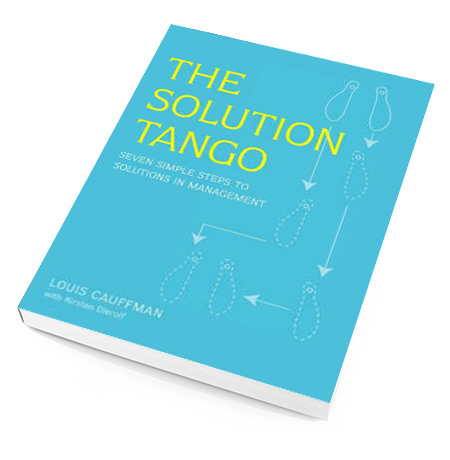Episode 4 – The Man in the Middle: A Solution Focused Feuilleton
Their mutual anger and distrust caused major problems. John and Peter had been slated to work together on the new project of dismantling the production line, but it looked like the project would run into serious problems if Peter and John couldn’t reconcile. Employees began gossiping about the “bad chemistry” between their two managers.

The fight kept Peter awake at night. He came to work tired and quick- tempered. For the first time in many years he complained to his wife about work. Peter told her: “Now I understand what the saying ‘lonely at the top’ means. It’s no longer safe to talk to anybody about anything. I wonder if I should look around for a job somewhere else.”
When the budgets for the dismantling project had to be presented to the top management, Peter refused to support John’s budget proposal. In the middle of John’s presentation Peter remarked bluntly: “This proposal is rubbish. I will not work in such an unprofessional way, and I will not take any responsibility for the safety of my people who have to dismantle the production line.” John couldn’t control himself any longer. In the middle of the meeting he called Peter “an incompetent, sneaky old pig.”
The CEO was not amused. He adjourned the meeting and summoned both men to his office. A massive brawl broke out there. Jeff had to refrain himself from firing both of them on the spot. He realized the enormous strains that both managers were under. Jeff wanted to fire neither John nor Peter — they were both highly esteemed managers with proven track records. After explaining that Solteam. wasn’t a play- ground where little boys could fight over a ball, the CEO told them that he refused to stoop to such childish matters. They had to clear it up themselves.
The CEO had no choice but to inform his board of directors who immediately invited John for a meeting. They explained to him that they saw Peter as the only manager within Solteam. capable of heading up this project. Peter had built the factory that had to be dismantled: “He knows the ins and outs of the place. For safety reasons, we are convinced that Peter is the only one who should take care of the dismantling project.” John grumbled a bit (he even considered giving the management the ultimatum “Fire Peter or I will leave”), but, wisely, he kept quiet and decided to leave Peter alone. He even mailed Peter to explain the management’s point of view and wished Peter — not without double meaning — “Good luck.”
In the course of the following weeks John and Peter kept avoiding each other. However, it was clear that Peter had lost his old zest. He repeatedly expressed his doubts to his closest employees, had regular outbursts, and was late delivering project proposals. At home he also became more and more grumpy, slept very poorly, and lost some weight. He skipped his bridge evenings to work late at the office.
One day Peter was standing next to the coffee machine when the CEO walked in. Always keen on personal contact with his personnel, Jeff asked Peter how things were going. Peter blushed, started to sweat and stutter, and went to his office without the coffee. The CEO followed him and prompted him about what was going on. Peter poured his heart out: “I can’t do it anymore. Everyone is working against me. I don’t believe that the new project will succeed. I am working my butt off without any results. Maybe I should resign.” The CEO was shocked. He wasn’t used to hearing Peter talk like that. And it certainly wasn’t the kind of language used in the macho world of Solteam.
Jeff went back to his office to think about the situation. He immediately ruled out drastic changes: no one would get fired, promoted, or demoted. He still believed John and Peter were the right people in the right places for the company. But what should he do?
(to be continued)
Read episode 5
Back to episode overview
‘The Man in the middle’ is an excerpt from the book ‘The Solution Tango’ (and ‘Solution Focused Coaching’ e-book) by Louis Cauffman. This book presents a new approach to conquering the numerous challenges, problems, and failures that managers encounter at work, many of which are people-related. An important lesson identified in the book is that a manager must act as both the leader who provides direction for a team or company and as the coach who enables others to make the most of their skills, enabling the individual and the organization to succeed. A seven-step framework to enhance problem-solving capabilities, examples and tips, and a survival kit for sinking managers will help managers improve their people skills and learn how to approach everyday issues from a positive perspective.
 LOUISCAUFFMAN.COM
LOUISCAUFFMAN.COM



